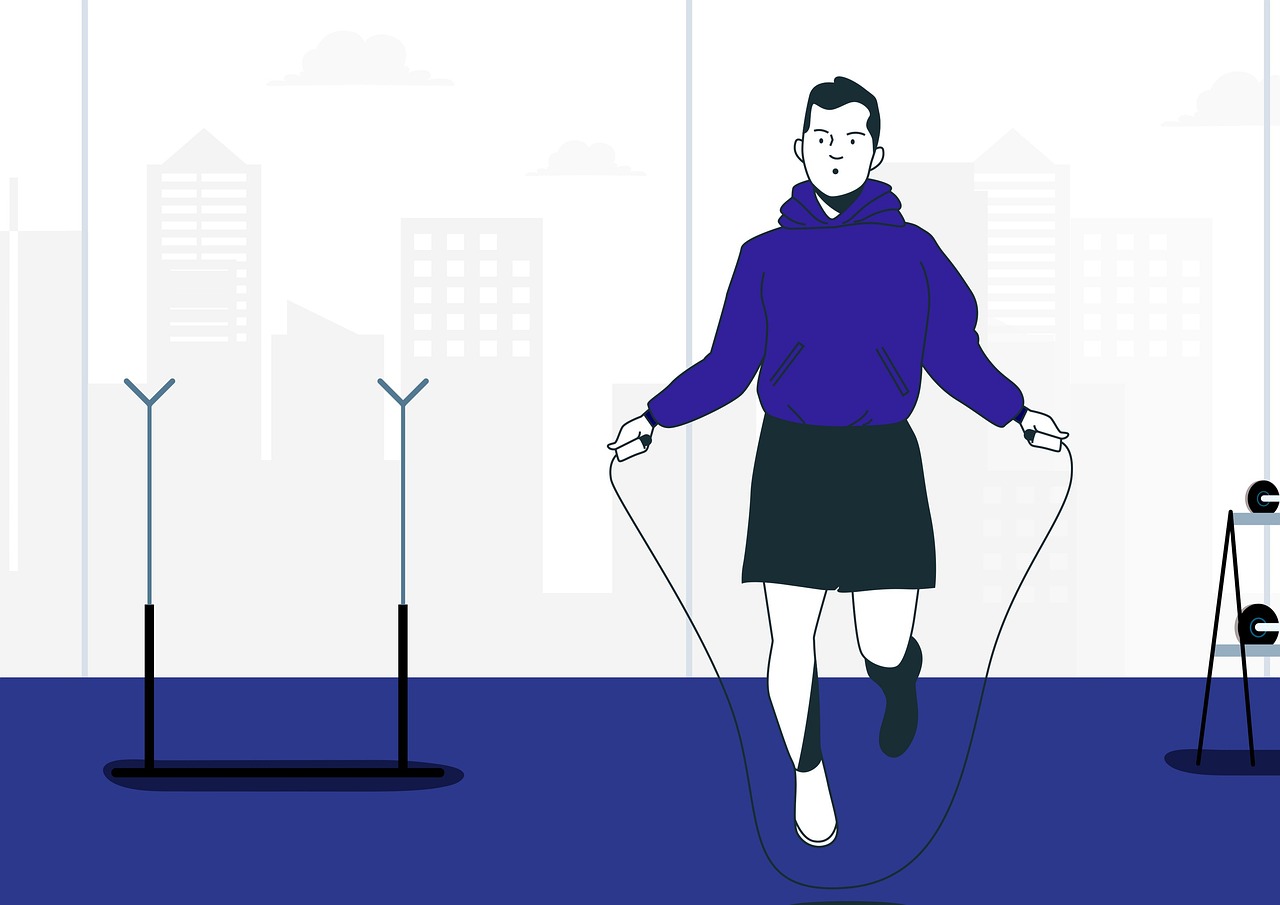When it comes to the best cardio for weight loss, a combination of cardiovascular exercise and strength training is key 1 3.
Cardio activities like brisk walking, running, and cycling burn calories to create a calorie deficit, while strength training builds lean muscle mass to boost metabolism and burn more fat 1 2 4.
Incorporating the right mix of these exercises along with a balanced diet can maximize weight loss results 3.
For optimal weight loss benefits, experts recommend 150-300 minutes of moderate-intensity cardio or 75-150 minutes of vigorous cardio like brisk walking and running per week, combined with 2-3 days of strength training 2 4.
This balanced approach not only helps shed pounds but also prevents weight regain by increasing muscle tissue that burns more calories than fat 4.
Aerobic Exercises
Brisk walking and running are excellent aerobic exercises that can effectively aid in weight loss.
They are simple, accessible, and require no special equipment, making them ideal for individuals seeking convenient ways to incorporate cardio into their routines.
Brisk Walking
Brisk walking is a low-impact yet highly effective form of cardio that can burn a significant number of calories. Here are some key points about brisk walking:
- Calorie Burn: A 155-pound person can burn approximately 235 calories in 30 minutes of brisk walking at a pace of 4 mph 1.
- Intensity: Aim for a pace that elevates your heart rate to a moderate intensity level, which is typically between 50-70% of your maximum heart rate 2.
- Consistency: Consistency is key for weight loss. Experts recommend at least 150 minutes of moderate-intensity aerobic activity, such as brisk walking, per week 3.
Running
Running is a high-intensity aerobic exercise that can significantly boost calorie burn and contribute to weight loss. Here are some key points about running:
- Calorie Burn: A 155-pound person can burn approximately 298 calories in 30 minutes of running at a pace of 5 mph 1.
- Intensity: Running is considered a vigorous-intensity activity, engaging your heart rate at 70-85% of your maximum heart rate 2.
- Interval Training: Incorporate interval training by alternating periods of high-intensity running with periods of recovery to maximize calorie burn and improve cardiovascular fitness 4.
| Exercise | Calories Burned (30 mins) |
|---|---|
| Brisk Walking (4 mph) | 235 calories |
| Running (5 mph) | 298 calories |
Remember, consistency and gradually increasing the duration and intensity of your aerobic exercises are crucial for achieving sustainable weight loss results 1 2 34.
Skipping or Jumping Rope
A Simple Yet Effective Cardio Exercise
Skipping rope, or jumping rope, is a simple yet remarkably effective cardio exercise for weight loss.
It’s an inexpensive and convenient option that can be done almost anywhere, making it an excellent choice for those seeking a versatile workout.
Here are some key points about skipping rope:
- Calorie Burn: A 155-pound person can burn approximately 372 calories in 30 minutes of jumping rope at a moderate pace 1. This high calorie burn rate makes it an efficient exercise for creating a calorie deficit, which is essential for weight loss.
- Cardiovascular Benefits: Jumping rope is a vigorous aerobic exercise that engages multiple muscle groups and elevates your heart rate, improving cardiovascular fitness 2.
- Portability: A jump rope is lightweight and portable, allowing you to incorporate this exercise into your routine, whether at home, at the park, or even while traveling 3.
- Versatility: Jumping rope offers versatility in terms of intensity and duration. You can adjust the pace, incorporate different jumping styles, or try interval training to keep your workouts challenging and engaging 4.
Incorporating Skipping Rope into Your Routine
To effectively incorporate skipping rope into your weight loss journey, consider the following tips:
- Start Gradually: If you’re new to jumping rope, start with shorter intervals and gradually increase the duration and intensity as your fitness level improves 1.
- Warm-up and Cool-down: Always warm up with some light cardio and stretching before jumping rope, and cool down with stretches afterward to prevent injuries 2.
- Combine with Other Exercises: Incorporate skipping rope into a well-rounded exercise routine that includes strength training and other cardio exercises for optimal weight loss results 3.
- Vary Your Routine: Experiment with different jumping styles, such as high knees, double unders, or alternating foot jumps, to keep your workouts challenging and engaging 4.
| Exercise | Calories Burned (30 mins) |
|---|---|
| Jumping Rope (Moderate Pace) | 372 calories |
Remember, consistency and gradually increasing the intensity and duration of your skipping rope sessions can contribute significantly to your weight loss goals while providing an enjoyable and convenient cardio workout.
Planks and Variations
The Plank: A Simple Yet Effective Core Exercise
The plank is a deceptively simple exercise that engages multiple muscle groups, making it an excellent choice for burning calories and aiding in weight loss 1.
Despite its stationary nature, the plank is a highly effective isometric exercise that challenges your core, shoulders, and legs simultaneously.
- Calorie Burn: While the exact calorie burn varies based on factors like body weight and intensity, a 155-pound person can burn approximately 84 calories in 30 minutes of holding a plank position 2.
- Core Strength: The plank is renowned for its ability to strengthen the core muscles, including the rectus abdominis, obliques, and lower back muscles 3. A strong core not only improves posture and balance but also aids in performing other exercises more effectively.
- Muscle Engagement: Beyond the core, the plank engages various muscle groups, such as the shoulders, chest, and legs, making it a comprehensive full-body exercise 4.
Incorporating Plank Variations
To keep your workouts challenging and engaging, consider incorporating plank variations into your routine.
These variations target different muscle groups and can increase the intensity of the exercise, leading to higher calorie burn.
- Side Planks: This variation targets the obliques and improves lateral stability 1.
- Plank Jacks: By incorporating leg movements, plank jacks add an extra challenge and engage the lower body 2.
- Plank Shoulder Taps: This variation involves tapping the opposite shoulder with each hand, engaging the core and shoulders 3.
- Plank with Leg Raises: Raising one leg at a time during the plank targets the lower abdominals and hip flexors 4.
| Exercise | Calories Burned (30 mins) |
|---|---|
| Plank (155 lbs) | 84 calories |
Remember, proper form is crucial when performing planks and their variations. Start with the basic plank position, gradually increasing the duration and intensity as your core strength improves. Incorporating planks into your routine can contribute significantly to your overall weight loss goals while building a strong, functional core.
Push-Ups and Pull-Ups
Push-Ups: A Versatile and Effective Exercise
Push-ups are a classic bodyweight exercise that can be an excellent addition to your cardio routine for weight loss. Despite being a strength-training exercise, push-ups can elevate your heart rate, making them an effective calorie-burning activity. Here are some key points about incorporating push-ups into your weight loss journey:
- Calorie Burn: A 155-pound person can burn approximately 112 calories in 30 minutes of performing push-ups at a moderate pace 1. The calorie burn can be increased by incorporating variations or increasing the intensity.
- Full-Body Workout: Push-ups engage multiple muscle groups, including the chest, shoulders, triceps, and core, making them a comprehensive full-body exercise 2.
- Versatility: Push-ups offer numerous variations, such as wide-arm, diamond, decline, or elevated push-ups, allowing you to target different muscle groups and increase the challenge 3.
- Convenience: Push-ups can be performed anywhere, without the need for equipment, making them a convenient exercise to incorporate into your daily routine 4.
Pull-Ups: Building Upper Body Strength
Pull-ups are a challenging yet highly effective exercise that targets the back, shoulders, and arm muscles. While primarily a strength-training exercise, pull-ups can also contribute to your cardio routine and aid in weight loss. Here are some key points about incorporating pull-ups into your fitness regimen:
- Calorie Burn: A 155-pound person can burn approximately 197 calories in 30 minutes of performing pull-ups 1.
- Upper Body Strength: Pull-ups are an excellent exercise for building upper body strength, which can improve overall fitness and metabolic rate 2.
- Progression: If you cannot perform full pull-ups initially, start with assisted pull-ups using a resistance band or a pull-up assist machine, and gradually work your way up to unassisted pull-ups 3.
- Variation: Incorporate variations like wide-grip, close-grip, or chin-ups to target different muscle groups and keep your workouts challenging 4.
| Exercise | Calories Burned (30 mins) |
|---|---|
| Push-Ups (Moderate Pace) | 112 calories |
| Pull-Ups | 197 calories |
Remember, proper form and gradual progression are crucial when incorporating push-ups and pull-ups into your routine. Start with a manageable number of repetitions and gradually increase the intensity and duration as your strength improves. Combining these exercises with other cardio and strength-training activities can contribute significantly to your overall weight loss goals.
Squats and Lunges
Squats: A Powerful Lower Body Exercise
Squats are a compound exercise that targets multiple muscle groups, making them an excellent choice for burning calories and aiding in weight loss. Here are some key points about incorporating squats into your cardio routine:
- Calorie Burn: A 155-pound person can burn approximately 223 calories in 30 minutes of performing squats at a moderate pace 1.
- Muscle Engagement: Squats engage the quadriceps, hamstrings, glutes, and core muscles, providing a full-body workout 2.
- Cardiovascular Benefits: When performed with proper form and intensity, squats can elevate your heart rate, making them an effective cardio exercise 3.
- Variations: Incorporate variations like jump squats, sumo squats, or squat holds to increase the challenge and target different muscle groups 4.
Lunges: A Dynamic Lower Body Exercise
Lunges are a dynamic exercise that targets the lower body muscles, particularly the quadriceps, hamstrings, and glutes. Here are some key points about incorporating lunges into your weight loss journey:
- Calorie Burn: A 155-pound person can burn approximately 298 calories in 30 minutes of performing lunges at a moderate pace 1.
- Balance and Stability: Lunges challenge your balance and stability, engaging your core muscles and improving overall body control 2.
- Versatility: Lunges can be performed in various directions, such as forward, backward, or lateral, allowing you to target different muscle groups 3.
- Progression: Start with stationary lunges and progress to walking lunges or weighted lunges to increase the intensity and challenge 4.
| Exercise | Calories Burned (30 mins) |
|---|---|
| Squats (Moderate Pace) | 223 calories |
| Lunges (Moderate Pace) | 298 calories |
Incorporating Squats and Lunges
To effectively incorporate squats and lunges into your cardio routine for weight loss, consider the following tips:
- Proper Form: Maintain proper form to avoid injury and maximize the effectiveness of the exercises 1.
- Warm-up and Cool-down: Always warm up with some light cardio and stretching before performing squats and lunges, and cool down with stretches afterward 2.
- Combine with Other Exercises: Incorporate squats and lunges into a well-rounded exercise routine that includes other cardio and strength-training exercises for optimal weight loss results 3.
- Progression: Gradually increase the intensity and duration of your squat and lunge sessions as your fitness level improves 4.
Remember, consistency and proper form are crucial when incorporating squats and lunges into your weight loss journey. These exercises not only burn calories but also build strength and improve overall fitness, contributing to sustainable weight loss results.
Yoga
Yoga offers numerous benefits for weight loss and overall well-being. It can help manage stress and reduce cortisol levels, which are linked to increased abdominal fat, decreased muscle mass, and cravings for unhealthy foods 5.
Practicing yoga improves mindfulness and awareness of the body, which can decrease emotional eating, stress eating, and binge eating behaviors that sabotage weight loss efforts 5.
Studies have shown that practicing yoga leads to healthier eating habits, including lower fat intake and increased consumption of vegetables and whole grains 5.
Additionally, yoga communities can provide a supportive environment and positive role models that encourage healthy behaviors and weight management 5.
Physical Benefits of Yoga for Weight Loss
- Increased Physical Activity: More physically active styles of yoga like Ashtanga, vinyasa, and power yoga can help burn calories and prevent weight gain 6. Even restorative yoga has been shown to be effective for helping overweight women lose weight, including abdominal fat 6.
- Muscle Toning: Yoga can increase muscle mass and tone, contributing to weight loss and maintenance 5. The practice builds muscle through using the body’s own weight as resistance, which helps burn calories 7.
- Joint Pain Relief: Yoga can help reduce joint pain, which allows for increased physical activity and daily movement 5.
Mindful Eating and Stress Management
- Mindful Eating: Practicing yoga can increase mindfulness and awareness, which may help people resist unhealthy foods and be more in tune with feelings of fullness 6. Yoga encourages mindful eating by helping practitioners become more aware of their body’s hunger and satiety cues 7.
- Stress Management: Yoga can help manage stress, which is linked to weight gain. The breathing and meditation aspects of yoga can lower cortisol levels and reverse the negative effects of stress on weight 7.
Incorporating Yoga for Weight Loss
To effectively incorporate yoga into a weight loss journey, it’s recommended to practice 3-5 times per week for at least 1 hour, with a mix of more active and more gentle/restorative styles 6. Practicing yoga can lead to healthier eating habits, such as reducing dietary fat and increasing intake of vegetables, whole grains, and soy 7.
| Yoga Benefit | Description |
|---|---|
| Mindful Eating | Increased awareness of hunger and satiety cues 7 |
| Stress Management | Reduced cortisol levels and stress-related weight gain 7 |
| Physical Activity | Calorie burn through active yoga styles 6 |
| Muscle Toning | Increased muscle mass and tone through body weight resistance 5 7 |
Studies have found yoga can reduce waist-hip ratio and body mass index in overweight/obese individuals 7. Additionally, restorative yoga has been shown to improve fasting glucose levels, indicating improved metabolic health 7. Yoga has also been associated with lower rates of disordered eating compared to other forms of exercise 7.
FAQs
1. What is the simplest cardiovascular exercise for shedding pounds? The simplest and most effective cardio exercises for weight loss include High-intensity interval training (HIIT), which involves alternating between short bursts of intense activity and lower intensity recovery periods; using a stair climber; running; walking; cycling; sprinting; using an elliptical machine; and jumping rope.
2. What are the top cardiovascular workouts for slimming down? The most recommended cardio workouts for losing weight include jump squats, as suggested by NASM-certified personal trainer Alex McBrairty; running and walking intervals; stationary bike sprints; burpees; and jumping jacks.
3. Which cardio exercise burns the most fat? Running takes the lead in burning the most calories per hour. Other excellent fat-burning cardio exercises include stationary bicycling, jogging, swimming, and High-intensity interval training (HIIT). HIIT is particularly effective as it not only burns a high number of calories during the workout but also continues to burn calories for up to 24 hours afterward.
4. What is considered the ultimate exercise for weight reduction? Walking is a highly effective exercise for weight reduction, with individuals potentially reducing their body fat by an average of 1.5% and waist circumference by 2.8 cm by walking for 50-70 minutes three times a week. However, jogging and running are often hailed as the best for weight loss, as these full-body exercises are highly efficient in burning calories and improving cardiovascular health.


